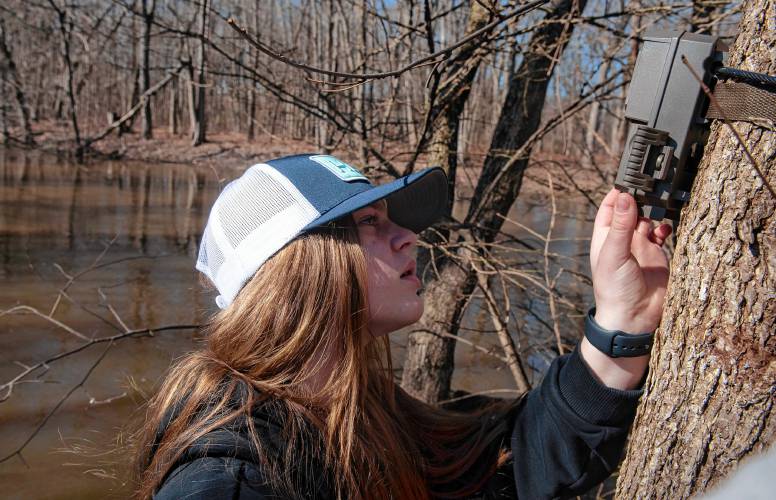Wildlife Spotters: Hatfield elementary students tracking animal activity as part of science project
| Published: 03-11-2024 1:15 PM |
HATFIELD — If deer, bobcats or foxes are passing through their neighborhood, Hatfield Elementary School students have a new way of finding out.
With the help of two Amherst College students and two Smith Academy eighth-graders, John Higuera and Ted Prajzner’s fifth grade class took part last Friday in setting up a trail camera in the woods by the Mill River.
Amherst College freshman Kaitlyn Huang and junior Mimi Hamada-Peña, with the citizen science research project MassMammals Watch, said the project initially was focused on black bears, and has gathered significant data on their prevalence.
The project has since expanded to cover all mammals, and uses the small, inexpensive trail cameras to document animal activity wherever they’re placed. Data from the cameras can then be mapped and tabulated. Schools have become a growing focus of the citizen science initiative.
Huang and Hamada-Peña passed around two carefully sealed artifacts — a bear tooth and claw — along with a clump of bear fur, collected as another means of tracking the region’s largest mammal.
Giving the younger students a taste of what their camera might reveal, Madison Didonna-Renner and Harper Phaneuf presented a slide show of images from Smith Academy’s trail cam.
The camera, set up in the fall of 2022, has captured numerous images of deer along with the occasional bobcat, fox and coyote.
The camera is triggered by movement, so some images are less useful to science than others.
Article continues after...
Yesterday's Most Read Articles
 Northampton bans auto dealerships near downtown; zone change won’t affect Volvo operation on King Street
Northampton bans auto dealerships near downtown; zone change won’t affect Volvo operation on King Street
 Proposed Hatfield pickleball/tennis building raising eyebrows
Proposed Hatfield pickleball/tennis building raising eyebrows
 South Hadley man killed in I-91 crash
South Hadley man killed in I-91 crash
 ‘Home away from home’: North Amherst Library officially dedicated, as anonymous donor of $1.7M revealed
‘Home away from home’: North Amherst Library officially dedicated, as anonymous donor of $1.7M revealed
 Police respond to alcohol-fueled incidents in Amherst
Police respond to alcohol-fueled incidents in Amherst
 Public gets a look at progress on Northampton Resilience Hub
Public gets a look at progress on Northampton Resilience Hub
“We get a lot a squirrels,” Madison said.
One image showed a coyote that was part wolf, she said, indicating there are wolves in this area and they’re breeding with coyotes.
Hamada-Peña said she enjoyed images of birds, which are usually just a blur because their movement is too fast for the camera to capture.
With the school’s playing fields stretching down to the Mill River, there was limited space for setting up the camera.
The four older students eventually decided on a tree and secured it at head height, facing downstream toward the woods on the other bank. With a range of about 30 yards, it may be able to capture activity there.
Higuera said the plan is to collect data from the camera every week. If it fails to capture much activity, the class will try to figure out a new site.






 State Senate budget funds free community college for all
State Senate budget funds free community college for all ‘We can just be who we are’: Thousands show support for LGBTQ community at Hampshire Pride
‘We can just be who we are’: Thousands show support for LGBTQ community at Hampshire Pride Doors open at Tilton Library’s temporary home at South Deerfield Congregational Church
Doors open at Tilton Library’s temporary home at South Deerfield Congregational Church Area property deed transfers, May 2
Area property deed transfers, May 2
